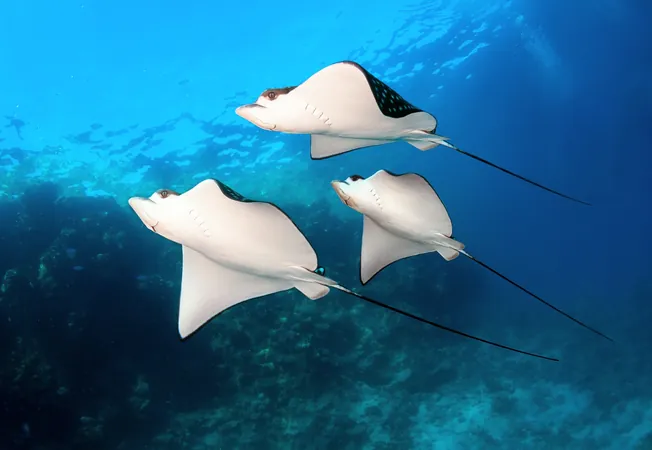
Revolutionizing Marine Conservation: The Game-Changing Technology Tracking Endangered Rays
2025-07-26
Author: Daniel
Unveiling the Secrets of Endangered Rays
Marine scientists have traditionally tracked species like sharks and turtles, but rays have mostly eluded these high-tech tracking efforts. While biologging—using tiny sensors to monitor movement and behavior—has been successful in various marine species, the unique characteristics of rays have posed serious challenges.
Introducing the Whitespotted Eagle Ray
Among the most stunning yet endangered creatures is the whitespotted eagle ray, a six-and-a-half-foot coastal predator whose numbers are dwindling, earning it a spot on the International Union for Conservation of Nature's endangered list. Dr. Matt Ajemian from Florida Atlantic University has spearheaded innovative research that has led to the development of cutting-edge tracking technology capable of monitoring these elusive creatures for up to 60 hours.
The Challenge of Tracking Rays
Unlike sharks, rays possess flat bodies lacking the sturdy fins needed for traditional tracking devices. Their velvety skin further complicates the attachment of equipment, which is further hindered by strict conservation regulations limiting the handling time. As a result, detailed studies on the behavior of pelagic rays are disappointingly sparse.
A Breakthrough in Tracking Technology
The new tracking device created by Dr. Ajemian's team is a compact marvel of engineering. It integrates a camera, motion sensors, hydrophone, satellite pinger, and acoustic beacon into a lightweight package. The innovation lies in a soft strap that loops through the ray's spiracles, securing the tag without harming the animal. Attachment now requires just eight seconds of gentle restraint.
Revealing Underwater Behavior
Field trials off Bermuda showed that tagged rays retained their devices for an impressive average of 21 hours, with one ray managing to keep it on for nearly 60 hours. Researchers captured stunning video footage demonstrating the rays' movements over seagrass, coral, and reef ledges, revealing complex underwater behaviors like clam crunching.
AI Technology Enhances Tracking Efficiency
The tracking devices use cutting-edge AI technology to analyze movement patterns, accurately identifying behaviors such as swimming, browsing, and digging with remarkable precision. This predictive modeling is paving the way for broader applications in marine biology.
Why Eagle Rays Matter
Eagle rays play a crucial role in maintaining the balance of marine ecosystems, particularly by controlling populations of clams and conchs. However, their numbers have plummeted due to bycatch, habitat degradation, and targeted fisheries. Understanding their feeding patterns is essential for creating effective conservation strategies.
A Promising Future for Ray Conservation
The technology developed for tracking rays could be adapted for other species with similar anatomical features, broadening its application across various marine habitats. With rising interest in marine conservation, these advances may help us better understand complex interactions within ocean ecosystems, offering a glimpse into the intricate web of life beneath the waves.
Conclusion: A New Era in Marine Research
As marine scientists continue to innovate, the future looks bright for endangered rays and other marine species. The research, published in the journal *Animal Biotelemetry*, illustrates how modern technology can illuminate the hidden lives of oceanic life forms, potentially altering conservation strategies for years to come.





 Brasil (PT)
Brasil (PT)
 Canada (EN)
Canada (EN)
 Chile (ES)
Chile (ES)
 Česko (CS)
Česko (CS)
 대한민국 (KO)
대한민국 (KO)
 España (ES)
España (ES)
 France (FR)
France (FR)
 Hong Kong (EN)
Hong Kong (EN)
 Italia (IT)
Italia (IT)
 日本 (JA)
日本 (JA)
 Magyarország (HU)
Magyarország (HU)
 Norge (NO)
Norge (NO)
 Polska (PL)
Polska (PL)
 Schweiz (DE)
Schweiz (DE)
 Singapore (EN)
Singapore (EN)
 Sverige (SV)
Sverige (SV)
 Suomi (FI)
Suomi (FI)
 Türkiye (TR)
Türkiye (TR)
 الإمارات العربية المتحدة (AR)
الإمارات العربية المتحدة (AR)